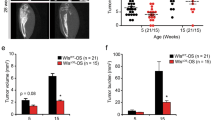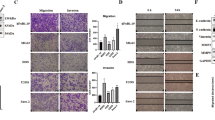Abstract
Osteosarcoma (OS) is the most frequent pediatric malignant bone tumor that has a high propensity for metastases. Through osteoblast-specific alteration of p53 status, we developed a genetically engineered mouse model of localized and metastatic OS to gain an understanding into the molecular pathogenesis of OS. Microarray analysis of both localized tumors and metastatic tumors identified the downregulation of the naked cuticle homolog 2 (NKD2) gene, a negative regulator of Wnt signaling. Overexpression of NKD2 in metastatic human and mouse OS cells significantly decreases cell proliferation, migration and invasion ability in vitro and drastically diminishes OS tumor growth and metastasis in vivo, whereas downregulation enhances migratory and invasive potential. Evaluation of NKD2-overexpressing tumors revealed upregulation of tumor-suppressor genes and downregulation of molecules involved in blood vessel formation and cell migration. Furthermore, assessment of primary human OS revealed downregulation of NKD2 in metastatic and recurrent OS. Finally, we provide biological evidence that use of small-molecule inhibitors targeting the Wnt pathway can have therapeutic efficacy in decreasing metastatic properties in OS. Our studies provide compelling evidence that downregulation of NKD2 expression and alterations in associated regulated pathways have a significant role in driving OS tumor growth and metastasis.
This is a preview of subscription content, access via your institution
Access options
Subscribe to this journal
Receive 50 print issues and online access
$259.00 per year
only $5.18 per issue
Buy this article
- Purchase on Springer Link
- Instant access to full article PDF
Prices may be subject to local taxes which are calculated during checkout






Similar content being viewed by others
Accession codes
References
Ottaviani G, Jaffe N . The epidemiology of osteosarcoma. Cancer Treat Res 2009; 152: 3–13.
Wang LL . Biology of osteogenic sarcoma. Cancer J 2005; 11: 294–305.
Bacci G, Briccoli A, Rocca M, Ferrari S, Donati D, Longhi A et al. Neoadjuvant chemotherapy for osteosarcoma of the extremities with metastases at presentation: recent experience at the Rizzoli Institute in 57 patients treated with cisplatin, doxorubicin, and a high dose of methotrexate and ifosfamide. Ann Oncol 2003; 14: 1126–1134.
Kager L, Zoubek A, Potschger U, Kastner U, Flege S, Kempf-Bielack B et al. Primary metastatic osteosarcoma: presentation and outcome of patients treated on neoadjuvant Cooperative Osteosarcoma Study Group protocols. J Clin Oncol 2003; 21: 2011–2018.
Meyers PA, Heller G, Healey JH, Huvos A, Applewhite A, Sun M et al. Osteogenic sarcoma with clinically detectable metastasis at initial presentation. J Clin Oncol 1993; 11: 449–453.
Chen X, Bahrami A, Pappo A, Easton J, Dalton J, Hedlund E et al. Recurrent somatic structural variations contribute to tumorigenesis in pediatric osteosarcoma. Cell Rep 2014; 7: 104–112.
Kansara M, Thomas DM . Molecular pathogenesis of osteosarcoma. DNA Cell Biol 2007; 26: 1–18.
Petitjean A, Mathe E, Kato S, Ishioka C, Tavtigian SV, Hainaut P et al. Impact of mutant p53 functional properties on TP53 mutation patterns and tumor phenotype: lessons from recent developments in the IARC TP53 database. Hum Mutat 2007; 28: 622–629.
Brosh R, Rotter V . When mutants gain new powers: news from the mutant p53 field. Nat Rev Cancer 2009; 9: 701–713.
Donehower LA, Harvey M, Slagle BL, McArthur MJ, Montgomery CA Jr ., Butel JS et al. Mice deficient for p53 are developmentally normal but susceptible to spontaneous tumours. Nature 1992; 356: 215–221.
Donehower LA, Lozano G . 20 years studying p53 functions in genetically engineered mice. Nat Rev Cancer 2009; 9: 831–841.
Liu G, McDonnell TJ, Montes de Oca Luna R, Kapoor M, Mims B, El-Naggar AK et al. High metastatic potential in mice inheriting a targeted p53 missense mutation. Proc Natl Acad Sci USA 2000; 97: 4174–4179.
Olive KP, Tuveson DA, Ruhe ZC, Yin B, Willis NA, Bronson RT et al. Mutant p53 gain of function in two mouse models of Li-Fraumeni syndrome. Cell 2004; 119: 847–860.
Feng W, Shen L, Wen S, Rosen DG, Jelinek J, Hu X et al. Correlation between CpG methylation profiles and hormone receptor status in breast cancers. Breast Cancer Res 2007; 9: R57.
Lauvrak SU, Munthe E, Kresse SH, Stratford EW, Namlos HM, Meza-Zepeda LA et al. Functional characterisation of osteosarcoma cell lines and identification of mRNAs and miRNAs associated with aggressive cancer phenotypes. Br J Cancer 2013; 109: 2228–2236.
Baranwal S, Alahari SK . miRNA control of tumor cell invasion and metastasis. Int J Cancer 2009; 126: 1283–1290.
Luu HH, Kang Q, Park JK, Si W, Luo Q, Jiang W et al. An orthotopic model of human osteosarcoma growth and spontaneous pulmonary metastasis. Clin Exp Metastasis 2005; 22: 319–329.
Edamura K, Nasu Y, Takaishi M, Kobayashi T, Abarzua F, Sakaguchi M et al. Adenovirus-mediated REIC/Dkk-3 gene transfer inhibits tumor growth and metastasis in an orthotopic prostate cancer model. Cancer Gene Ther 2007; 14: 765–772.
Hsieh SY, Hsieh PS, Chiu CT, Chen WY . Dickkopf-3/REIC functions as a suppressor gene of tumor growth. Oncogene 2004; 23: 9183–9189.
Mizobuchi Y, Matsuzaki K, Kuwayama K, Kitazato K, Mure H, Kageji T et al. REIC/Dkk-3 induces cell death in human malignant glioma. Neuro-oncol 2008; 10: 244–253.
Veeck J, Bektas N, Hartmann A, Kristiansen G, Heindrichs U, Knuchel R et al. Wnt signalling in human breast cancer: expression of the putative Wnt inhibitor Dickkopf-3 (DKK3) is frequently suppressed by promoter hypermethylation in mammary tumours. Breast Cancer Res 2008; 10: R82.
Hoang BH, Kubo T, Healey JH, Yang R, Nathan SS, Kolb EA et al. Dickkopf 3 inhibits invasion and motility of Saos-2 osteosarcoma cells by modulating the Wnt-beta-catenin pathway. Cancer Res 2004; 64: 2734–2739.
Miretti S, Roato I, Taulli R, Ponzetto C, Cilli M, Olivero M et al. A mouse model of pulmonary metastasis from spontaneous osteosarcoma monitored in vivo by Luciferase imaging. PLoS ONE 2008; 3: e1828.
Hong SH, Briggs J, Newman R, Hoffman K, Mendoza A, LeRoith D et al. Murine osteosarcoma primary tumour growth and metastatic progression is maintained after marked suppression of serum insulin-like growth factor I. Int J Cancer 2009; 124: 2042–2049.
Hu T, Li C, Cao Z, Van Raay TJ, Smith JG, Willert K et al. Myristoylated Naked2 antagonizes Wnt-beta-catenin activity by degrading Dishevelled-1 at the plasma membrane. J Biol Chem 2010; 285: 13561–13568.
Rousset R, Mack JA, Wharton KA Jr ., Axelrod JD, Cadigan KM, Fish MP et al. Naked cuticle targets dishevelled to antagonize Wnt signal transduction. Genes Dev 2001; 15: 658–671.
Yan D, Wallingford JB, Sun TQ, Nelson AM, Sakanaka C, Reinhard C et al. Cell autonomous regulation of multiple Dishevelled-dependent pathways by mammalian Nkd. Proc Natl Acad Sci USA 2001; 98: 3802–3807.
Guo Y, Zi X, Koontz Z, Kim A, Xie J, Gorlick R et al. Blocking Wnt/LRP5 signaling by a soluble receptor modulates the epithelial to mesenchymal transition and suppresses met and metalloproteinases in osteosarcoma Saos-2 cells. J Orthop Res 2007; 25: 964–971.
Gotze S, Wolter M, Reifenberger G, Muller O, Sievers S . Frequent promoter hypermethylation of Wnt pathway inhibitor genes in malignant astrocytic gliomas. Int J Cancer 2010; 126: 2584–2593.
Nguyen DX, Massague J . Genetic determinants of cancer metastasis. Nat Rev 2007; 8: 341–352.
Baron R, Rawadi G . Wnt signaling and the regulation of bone mass. Curr Osteoporos Rep 2007; 5: 73–80.
Johnson AS, Couto CG, Weghorst CM . Mutation of the p53 tumor suppressor gene in spontaneously occurring osteosarcomas of the dog. Carcinogenesis 1998; 19: 213–217.
Flores RJ, Li Y, Yu A, Shen J, Rao PH, Lau SS et al. A systems biology approach reveals common metastatic pathways in osteosarcoma. BMC Syst Biol 2012; 6: 50.
Brennecke P, Arlt MJ, Campanile C, Husmann K, Gvozdenovic A, Apuzzo T et al. CXCR4 antibody treatment suppresses metastatic spread to the lung of intratibial human osteosarcoma xenografts in mice. Clin Exp Metastasis 2014; 31: 339–349.
Husmann K, Arlt MJ, Muff R, Langsam B, Bertz J, Born W et al. Matrix Metalloproteinase 1 promotes tumor formation and lung metastasis in an intratibial injection osteosarcoma mouse model. Biochim Biophys Acta 2013; 1832: 347–354.
Kimura R, Ishikawa C, Rokkaku T, Janknecht R, Mori N . Phosphorylated c-Jun and Fra-1 induce matrix metalloproteinase-1 and thereby regulate invasion activity of 143B osteosarcoma cells. Biochim Biophys Acta 2011; 1813: 1543–1553.
Muff R, Ram Kumar RM, Botter SM, Born W, Fuchs B . Genes regulated in metastatic osteosarcoma: evaluation by microarray analysis in four human and two mouse cell line systems. Sarcoma 2012; 2012: 937506.
Cheng JH, She H, Han YP, Wang J, Xiong S, Asahina K et al. Wnt antagonism inhibits hepatic stellate cell activation and liver fibrosis. Am J Physiol 2008; 294: G39–G49.
Kanda M, Nomoto S, Okamura Y, Hayashi M, Hishida M, Fujii T et al. Promoter hypermethylation of fibulin 1 gene is associated with tumor progression in hepatocellular carcinoma. Mol Carcinog 2011; 50: 571–579.
Wlazlinski A, Engers R, Hoffmann MJ, Hader C, Jung V, Muller M et al. Downregulation of several fibulin genes in prostate cancer. Prostate 2007; 67: 1770–1780.
Li C, Franklin JL, Graves-Deal R, Jerome WG, Cao Z, Coffey RJ . Myristoylated Naked2 escorts transforming growth factor alpha to the basolateral plasma membrane of polarized epithelial cells. Proc Natl Acad Sci USA 2004; 101: 5571–5576.
Li C, Hao M, Cao Z, Ding W, Graves-Deal R, Hu J et al. Naked2 acts as a cargo recognition and targeting protein to ensure proper delivery and fusion of TGF-alpha containing exocytic vesicles at the lower lateral membrane of polarized MDCK cells. Mol Biol Cell 2007; 18: 3081–3093.
Liu F, Woitge HW, Braut A, Kronenberg MS, Lichtler AC, Mina M et al. Expression and activity of osteoblast-targeted Cre recombinase transgenes in murine skeletal tissues. Int J Dev Biol 2004; 48: 645–653.
Dumble ML, Donehower LA, Lu X . Generation and characterization of p53 mutant mice. Methods Mol Biol 2003; 234: 29–49.
Schneider CA, Rasband WS, Eliceiri KW . NIH Image to ImageJ: 25 years of image analysis. Nat Methods 2012; 9: 671–675.
Molenaar JJ, Koster J, Zwijnenburg DA, van Sluis P, Valentijn LJ, van der Ploeg I et al. Sequencing of neuroblastoma identifies chromothripsis and defects in neuritogenesis genes. Nature 2012; 483: 589–593.
Acknowledgements
We thank Yiqun Zhang for technical assistance and Dr Neha Parikh for her assistance with figure layout and design. This work was supported by The Cancer Prevention and Research Institute of Texas (to SZ, T-KM, CL, PR, JH, LK, CJC, LAD, JTY), WWW.W Foundation, Inc. (QuadW) (to JTY), The St Baldrick’s Foundation (to JTY), the Sarcoma Foundation of America (to LAD), NIH R01 CA123238 (to AMCB) and NCI/NIH grant P30 CA125123 (to CJC).
Author information
Authors and Affiliations
Corresponding author
Ethics declarations
Competing interests
The authors declare no conflict of interest.
Additional information
Supplementary Information accompanies this paper on the Oncogene website
Supplementary information
Rights and permissions
About this article
Cite this article
Zhao, S., Kurenbekova, L., Gao, Y. et al. NKD2, a negative regulator of Wnt signaling, suppresses tumor growth and metastasis in osteosarcoma. Oncogene 34, 5069–5079 (2015). https://doi.org/10.1038/onc.2014.429
Received:
Revised:
Accepted:
Published:
Issue Date:
DOI: https://doi.org/10.1038/onc.2014.429
This article is cited by
-
NKD2 Trigger NF-κB Signaling Pathway and Facilitates Thyroid Cancer Cell Proliferation
Molecular Biotechnology (2023)
-
NKD2 is correlated with the occurrence, progression and prognosis of thyroid carcinoma
European Journal of Medical Research (2022)
-
Osteosarcoma
Nature Reviews Disease Primers (2022)
-
Expression pattern and clinical significance of β-catenin gene and protein in patients with primary malignant and benign bone tumors
Scientific Reports (2022)
-
cBAF complex components and MYC cooperate early in CD8+ T cell fate
Nature (2022)



